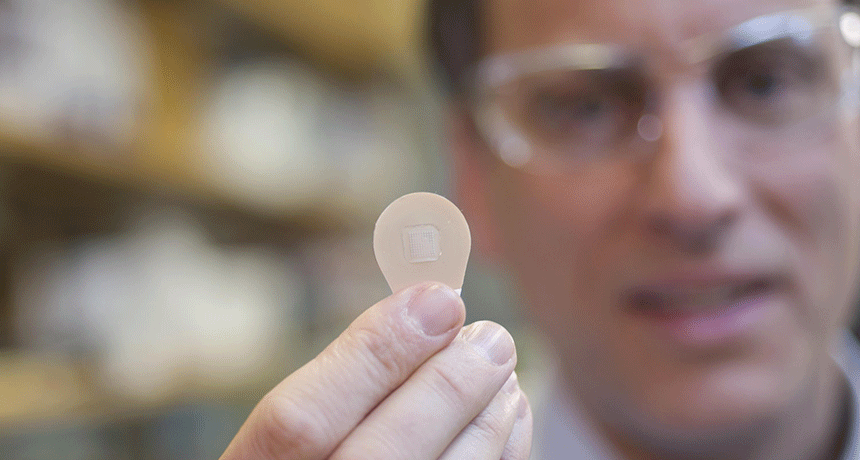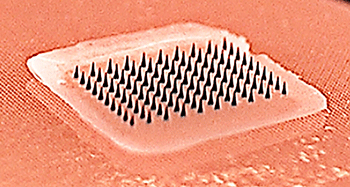Getting a flu ‘shot’ could become as easy as sticking on a bandage
Applying a flu-vaccine patch studded with 100 microneedles feels like pressing Velcro on the skin

In healthy adults, a flu-vaccine patch (seen here) packed with “microneedles” painlessly delivers a dose of flu vaccine and causes only mild side effects — ones similar to what a traditional flu shot causes.
Christopher Moore, Georgia Tech
Getting an influenza vaccine each year is important for keeping the illness from spreading across a community. But a lot of people don’t get vaccinated. One reason may be that they are skittish about being poked with a needle. And making time to go get a flu shot can be a hassle. Now, researchers have finished the first test of an easy, nearly painless alternative. It’s a skin patch that looks a lot like a small Band-Aid. But it’s studded with tiny needles that dissolve in the skin, delivering a dose of flu vaccine.
The researchers tested this new patch on healthy adults. Their goal was to make sure it safely delivered an effective dose. And it did. People treated with the patch had a similar immune response to those who got a standard flu shot. What’s more, nearly all patch users described the experience as painless.
The researchers described their results online June 27 in The Lancet.
The patch gets rid of a need to dispose of used needles. And unlike other vaccines, it can be stored at room temperature for at least a year. That could make it a good choice for use in countries with little refrigeration.

The designers suspect their patch could eventually end up on pharmacy shelves. That would make getting a flu “shot” more like picking up a bottle of aspirin than visiting a doctor. And that ease of pickup and use could lead to higher vaccination rates in the United States.
Myron Levine is a vaccine researcher at the University of Maryland School of Medicine in Baltimore. He wasn’t involved in the study. More testing of the patch is needed, he notes. But “what a great first start,” he adds. “I love the idea of not having to worry about a needle and syringe.”
One side of the patch looks like a regular adhesive bandage. The other side holds a small array of 100 hard, solid, cone-shaped microneedles. Each one is a little more than half a millimeter (about 2 one-hundredths of an inch) tall.
When pushed into the back of the wrist, the microneedles puncture the outer layer of the skin and then dissolve. Having the patch put on feels “a little like Velcro being pressed against the skin,” notes Mark Prausnitz. A chemical engineer at the Georgia Institute of Technology in Atlanta, he helped develop the new patch.
To test this vaccination technology, his team recruited 100 healthy adults. None of them had yet gotten a vaccine for that year’s flu season. Participants either received a normal flu shot or one of the patches. Some patch users even applied their own.
But not all patch users got the vaccine. Some instead got a placebo. Their patch, then, had no medicine. Scientists use placebos to test whether effects seen with a treatment are due to the drug or merely the expectation of what might happen when they get it.
All people who got a real vaccination (by patch or shot) experienced at most mild side effects (such as nausea, fatigue or headache). Those who got the shot reported pain at the site of injection. People treated with the patch’s microneedles described a slight itchiness.
If the patch becomes available, its ease of use might boost U.S. vaccination rates. (Only a little more than four out of every 10 adults were vaccinated against the flu in the 2014 to 2015 season.) The patch also could help with vaccinating large numbers of people in countries having limited medical services or health workers with little training.
Nor is such a technology restricted to flu vaccines. Last year, the same Georgia Tech team showcased a patch for delivering the measles vaccine.







